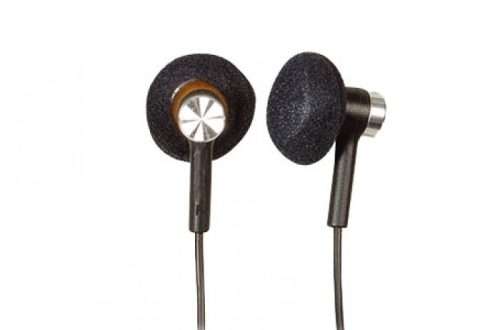
How to choose a power amplifier
Contents
Regardless of the style of music and the size of the venue, loudspeakers and power amplifiers take on the daunting task of converting electrical signals back into sound waves. The most difficult role is assigned to the amplifier: a weak output signal taken from instruments, microphones and other sources must be amplified to the level and power necessary for the normal operation of acoustics. In this review, the experts of the store “Student” will help simplify the task of choosing an amplifier.
Important parameters
Let’s look at the technical parameters on which the right choice depends.
How many watts?
The most important parameter of an amplifier is its output power. The standard unit of measure for electrical power is watt . The output power of amplifiers can vary considerably. To determine if an amplifier has enough power for your audio system, it is important to understand that manufacturers measure power in different ways. There are two main types of power:
- Peak power – the power of the amplifier, achieved at the maximum possible (peak) signal level. Peak power values are generally unsuitable for realistic evaluation and are declared by the manufacturer for promotional purposes.
- Continuous or RMS power is the power of the amplifier at which the coefficient of harmonic non-linear distortion is minimal and does not exceed the specified value. In other words, this is the average power at a constant, active, rated load, at which the AU can operate for a long time. This value objectively characterizes the measured operating power. When comparing the power of different amplifiers, make sure you are comparing the same value so that, figuratively speaking, you are not comparing oranges with apples. Sometimes manufacturers do not specify exactly what power is indicated in promotional materials. In such cases, the truth should be sought in the user manual or on the manufacturer’s website.
- Another parameter is the allowable power. With regard to acoustic systems, it characterizes the resistance of the speakers to thermal and mechanical damage during long-term operation with a noise signal such as ” pink noise “. In assessing the power characteristics of amplifiers, however, the RMS power still serves as a more objective value .
The power of the amplifier depends on the impedance (resistance) of the speakers connected to it. For example, an amplifier outputs power of 1100 W when speakers with a resistance of 8 ohms are connected, and when speakers with a resistance of 4 ohms are connected, already 1800 W , i.e., acoustics with a resistance of 4 ohms loads the amplifier more thanacoustics with a resistance of 8 ohms.
When calculating the required power, consider the area of \u200b\u200bthe room and the genre of music being played. It is clear that a folk guitar duet needs much less power to produce a sound than a band playing brutal death metal. The power calculation includes many variables such as the room acoustics , the number of spectators, the type of venue (open or closed) and many other factors. Approximately, it looks like this (mean square power values are given):
– 25-250 W – folk performance in a small room (such as a coffee shop) or at home;
– 250-750 W – performing pop music at medium-sized venues (jazz club or theater hall);
– 1000-3000 W – rock music performance at medium-sized venues (concert hall or festival on a small open stage);
– 4000-15000 W – performance of rock music or “metal” on large-scale venues (rock arena, stadium).
Amplifier operating modes
When examining the characteristics of various amplifier models, you will notice that for many of them the power is indicated per channel. Depending on the situation, channels can be connected in different modes.
In stereo mode, the two output sources (left and right outputs on the mixer ) are connected to the amplifier via a different channel each. The channels are connected to the speakers via an output connection, creating a stereo effect – the impression of a spacious sound space.
In parallel mode, one input source is connected to both amplifier channels. In this case, the power of the amplifier is evenly distributed over the speakers.
In bridged mode, the stereo amplifier becomes a more powerful mono amplifier. In bridge mode» only one channel works, the power of which is doubled.
Amplifier specifications typically list output power for both stereo and bridged modes. When operating in mono-bridge mode, follow the user manual to prevent damage to the amplifier.
Channels
When considering how many channels you need, the first thing to consider is how many speakers you want to connect to the amplifier and how. Most amplifiers are two-channel and can drive two speakers in stereo or mono. There are four-channel models, and in some the number of channels can be up to eight.
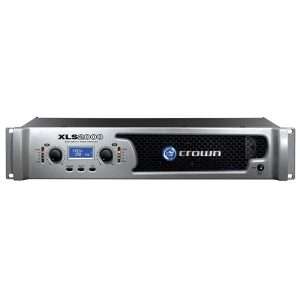
Two-channel amplifier CROWN XLS 2000
Multi-channel models, among other things, allow you to connect additional speakers to one amplifier . However, such amplifiers, as a rule, are more expensive than conventional two-channel ones with the same power, due to a more complex design and purpose.

Four-channel amplifier BEHRINGER iNUKE NU4-6000
Class D Amplifier
Power amplifiers are classified according to the way they work with the input signal and the principle of constructing amplifying stages. You will come across classes such as A, B, AB, C, D, etc.
The latest generations of portable audio systems are mainly equipped with class D amplifiers , which have high output power with low weight and dimensions. In operation, they are simpler and more reliable than all other types.
I/O types
Inputs
Most standard amplifiers are equipped with at least XLR ( microphone ) connectors, but most often there are ¼ inch, TRS and sometimes RSA connectors in addition to them. For example, Crown’s XLS2500 has ¼-inch, TRS, and XLR connectors .
Note that a balanced XLR connection is best used when the cable is long. In DJ systems, home audio systems, and some live audio systems where cables are shorter, it is convenient to use coaxial RCA connectors
Outputs
The following are the five main types of output connections used in power amplifiers:
1. Screw “terminals” – as a rule, in audio systems of previous generations, the bare ends of the speaker wires are twisted around the screw terminal clamp. This is a strong and reliable connection, but it takes time to fix it. Also, it is not convenient for concert musicians who often mount / dismantle sound equipment.

Screw terminal
2. Banana jack – a small cylindrical female connector; used to connect cables with plugs (plug connectors) of the same type. Sometimes it combines the conductors of a positive and negative output.
3. Speakon connectors – developed by Neutrik. Designed for high currents, can contain 2, 4 or 8 contacts. For speakers that do not have the appropriate plugs, there are Speakon adapters.
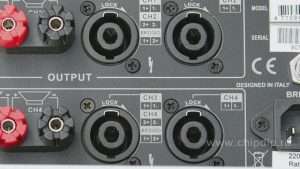
Speakon connectors
4. XLR – three-pin balanced connectors, use a balanced connection and have better noise immunity. Easy to connect and reliable.
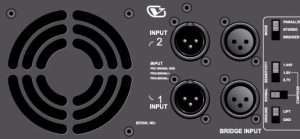
XLR connectors
5. ¼ inch connector – a simple and reliable connection, especially in the case of consumers with low power. Less reliable in case of high power consumers.
Built-in DSP
Some amplifier models are equipped with DSP (digital signal processing), which converts the analog input signal into a digital stream for further control and processing. Here are some of the DSP features integrated into the amplifiers:
Limiting – limiting the peaks of the input signal in order to prevent overloading the amplifier or damaging the speakers.
Filtering – Some DSP -equipped amplifiers have low-pass, high-pass, or bandpass filters to boost certain frequencies and/or prevent very low frequency (VLF) damage to the amplifier.
Crossover – division of the output signal into frequency bands to create the desired operating frequency ranges . (Passive crossovers in multi-channel speakers tend to overlap when using a DSP crossover in an amplifier.)
Compression is a method of limiting the dynamic range of an audio signal in order to amplify it or eliminate distortion.
Power amplifier examples
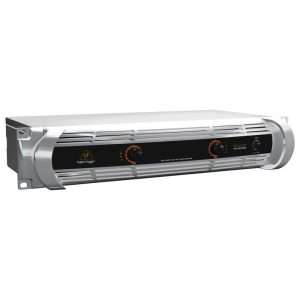 BEHRINGER iNUKE NU3000 |  Alto MAC 2.2 |
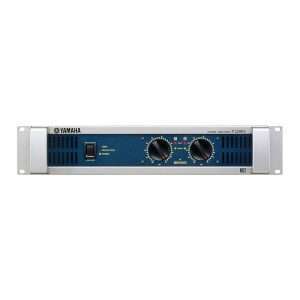 YAMAHA P2500S | 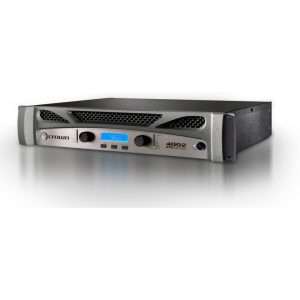 Crown XTi4002 |


